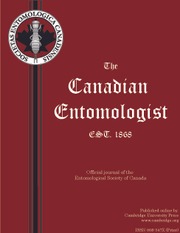Crossref Citations
This article has been cited by the following publications. This list is generated based on data provided by
Crossref.
Powell, Jerry A.
1962.
Taxonomic Studies on the Acleris gloverana-variana Complex, the Black-headed Budworms (Lepidoptera: Tortricidae).
The Canadian Entomologist,
Vol. 94,
Issue. 8,
p.
833.
Silver, G. T.
1963.
A Further Note on the Relation of Weather to Population Trends of the Black-headed Budworm, Acleris variana (Fern.) (Lepidoptera: Tortricidae).
The Canadian Entomologist,
Vol. 95,
Issue. 1,
p.
58.
Morris, R. F.
1965.
Contemporaneous Mortality Factors in Population Dynamics.
The Canadian Entomologist,
Vol. 97,
Issue. 11,
p.
1173.
Schmiege, Donald C.
1966.
The Relation of Weather to Two Population Declines of the Black-headed Budworm, Acleris variana (Fernald) (Lepidoptera: Tortricidae), in Coastal Alaska.
The Canadian Entomologist,
Vol. 98,
Issue. 10,
p.
1045.
Miller, C. A.
1966.
The Black-headed Budworm in Eastern Canada.
The Canadian Entomologist,
Vol. 98,
Issue. 6,
p.
592.
Shepherd, R. F.
and
Brown, C. E.
1971.
SEQUENTIAL EGG-BAND SAMPLING AND PROBABILITY METHODS OF PREDICTING DEFOLIATION BY MALACOSOMA DISSTRIA (LASIOCAMPIDAE: LEPIDOPTERA).
The Canadian Entomologist,
Vol. 103,
Issue. 10,
p.
1371.
Ives, W. G. H.
1973.
HEAT UNITS AND OUTBREAKS OF THE FOREST TENT CATERPILLAR, MALACOSOMA DISSTRIA (LEPIDOPTERA: LASIOCAMPIDAE).
The Canadian Entomologist,
Vol. 105,
Issue. 4,
p.
529.
1980.
Acleris variana (Fernald): Lepidoptera: Tortricidae.
EPPO Bulletin,
Vol. 10,
Issue. 1,
p.
49.
Berryman, Alan A.
1986.
Forest Insects.
p.
213.
Campbell, Ian M.
1989.
Does climate affect host-plant quality? Annual variation in the quality of balsam fir as food for spruce budworm.
Oecologia,
Vol. 81,
Issue. 3,
p.
341.
Kamata, N.
and
Igarashi, Y.
1994.
Influence of rainfall on feeding behavior, growth, and mortality of larvae of the beech caterpillar, Quadricalcarifera punctatella (Motschulsky) (Lep., Notodontidae).
Journal of Applied Entomology,
Vol. 118,
Issue. 1-5,
p.
347.
Nealis, V.G
Turnquist, R
and
Garbutt, R
2004.
Defoliation of juvenile western hemlock by western blackheaded budworm in Pacific coastal forests.
Forest Ecology and Management,
Vol. 198,
Issue. 1-3,
p.
291.
Weed, Aaron S.
Ayres, Matthew P.
and
Hicke, Jeffrey A.
2013.
Consequences of climate change for biotic disturbances in North American forests.
Ecological Monographs,
Vol. 83,
Issue. 4,
p.
441.
2019.
2019.
Howe, Michael
Graham, Elizabeth E.
and
Nelson, Kellen N.
2024.
Defoliator outbreaks track with warming across the Pacific coastal temperate rainforest of North America.
Ecography,
Vol. 2024,
Issue. 9,

